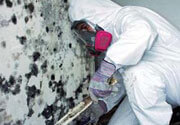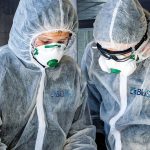Mold 101

Written by: Agustin Rodriguez, Vice President: Environmental Services

BluSky’s Environmental Services division manages hundreds of hazardous environmental remediation projects annually, including mold remediation, asbestos abatement, and other biohazard cleanup for commercial properties.
What is Mold?
Mold is a fungal growth that forms and spreads on various kinds of damp or decaying organic matter. There are many different mold species that come in many different colors. Molds are sometimes referred to as mildew. They are found both indoors and outdoors in all climates, during all seasons of the year. Outdoors, molds survive by using plants and decaying organic matter such as fallen leaves as a source of nutrition. Indoors, molds need moisture and a carbon source from building materials or building contents to grow.
Excess moisture is generally the cause of indoor mold growth. Molds reproduce by releasing tiny spores that float through the air until landing in other locations. When they settle on wet or moist surfaces, the spores can form new mold colonies. Moderate temperatures and available nutrient sources make most office buildings ideal for mold growth.
Exposure to molds has occurred throughout history. The types of molds found in office buildings are not rare or even unusual. It is important to understand that no indoor space is completely free from mold spores – not even a surgical operating room. Molds are everywhere, making our exposure to molds unavoidable, whether indoors or outdoors, at home or at work.
“Toxic Mold” & Stachybotrys chartarum
 Certain molds are toxigenic, meaning they can produce toxins (mycotoxins). However, the molds themselves are not toxic or poisonous. Hazards presented by molds that may produce mycotoxins, such as Stachybotrys chartarum, should be considered the same as other common molds which can grow in your house or workplace. There is contradicting research on whether toxigenic mold found indoors causes rare health conditions such as bleeding in the lungs. Research is ongoing in this area.
Certain molds are toxigenic, meaning they can produce toxins (mycotoxins). However, the molds themselves are not toxic or poisonous. Hazards presented by molds that may produce mycotoxins, such as Stachybotrys chartarum, should be considered the same as other common molds which can grow in your house or workplace. There is contradicting research on whether toxigenic mold found indoors causes rare health conditions such as bleeding in the lungs. Research is ongoing in this area.
Mold growing in buildings, whether it is Stachybotrys chartarum (Stachybotrys atra) or another mold, indicates that there is a problem with water or moisture. This is the first problem to address.
Identifying different molds
The three most common types of molds are Penicillium, Aspergillus, and Cladosporium.
Penicillium is typically blue or blue green in color, and there are over 200 varieties of it. It loves to grow on fabrics, walls, and insulation. Spores of Penicillium can cause allergic reactions like sneezing, coughing, wheezing and watery eyes in people. They’ve also been linked to asthma development in children.
Aspergillus is often found in stored grain and decaying vegetation that might be in your fridge. While its spores are usually harmless for most people, it can lead to Aspergillosis in some immune-compromised people, which is a serious lung infection and should be treated with care.
Like the two other common mold types above, Cladosporium can be found wherever it’s damp, and usually doesn’t lead to any serious health problems. However, it can worsen asthma in people who already have it, and in rare instances, it can lead to lung infections. It usually appears in clusters of black, green, or yellow spots.
Testing for mold
Surface sampling may be useful to determine if an area has been adequately cleaned or remediated. Sampling for mold should be conducted by professionals who have specific experience in designing mold sampling protocols, sampling methods, and interpreting results. Sample analysis should follow analytical methods recommended by the American Industrial Hygiene Association (AIHA), the American Conference of Governmental Industrial Hygienists (ACGIH), or other professional organizations.
An Industrial Hygienist (IH) should be engaged to collect samples for proper mold species identification and to provide a mold remediation protocol. BluSky can help find a qualified and trusted IH in your area, as well as advise on remediation approaches for your specific home or building conditions.
How do I get rid of mold?
It is impossible to get rid of all mold and mold spores indoors; some mold spores will be found floating through the air and in normal dust. The mold spores will not grow if moisture is not present. Indoor mold growth can and should be prevented or controlled by controlling moisture indoors. If there is mold growth in your home or building, you must clean up the mold and fix the water problem. If you clean up the mold, but don’t fix the water problem – most likely, the mold problem will come back.
Mold Prevention
- Fix leaky plumbing and leaks in the building envelope as soon as possible.
- Watch for condensation and wet spots. Fix source(s) of moisture problem(s) as soon as possible.
- Prevent moisture due to condensation by increasing surface temperature or reducing the moisture level in air (humidity). To increase surface temperature, insulate or increase air circulation. To reduce the moisture level in air, repair leaks, increase ventilation (if outside air is cold and dry), or dehumidify (if outdoor air is warm and humid).
- Keep heating, ventilation, and air conditioning (HVAC) drip pans clean, flowing properly, and unobstructed.
- Vent moisture-generating appliances, such as dryers, to the outside where possible.
- Maintain low indoor humidity, below 60% relative humidity (RH), ideally 30-50%, if possible.
- Perform regular building/HVAC inspections and maintenance as scheduled.
- Clean and dry wet or damp spots within 48 hours.
- Don’t let foundations stay wet. Provide drainage and slope the ground away from the foundation.
Remediation
Now that we’ve covered the basic principles of mold identification, potential health effects, common species, testing, and prevention; we know that encountering mold in your home or building can be an overwhelming experience. Many questions may arise when you encounter this condition, especially  following an event like water damage, but know that help is just a phone call away.
following an event like water damage, but know that help is just a phone call away.
BluSky Restoration Contractors has a team of experienced and highly trained technicians to help find a solution and remedy to your mold problems and damage.
Our teams can be reached at 800.266.5677 24/7/365.
Sources: EPA.gov:
A Brief Guide to Mold, Moisture and Your Home | US EPA
Mold Remediation in Schools and Commercial Buildings Guide: Chapter 1 | US EPA